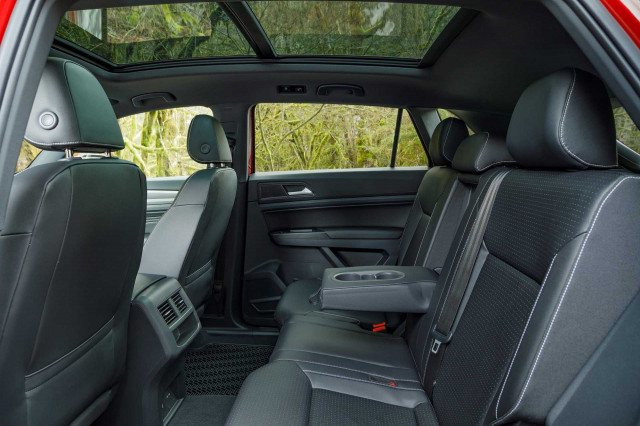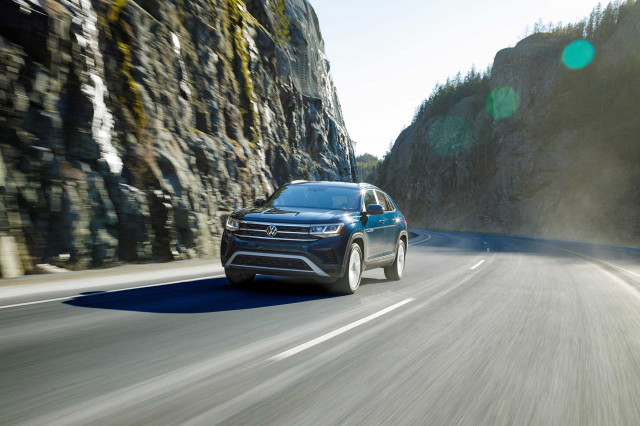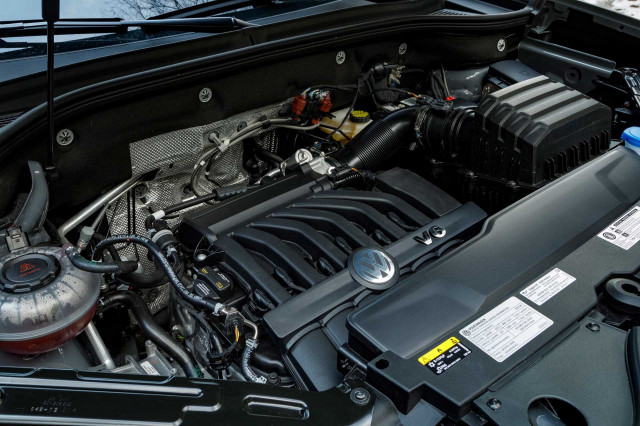Until now, Volkswagen’s answer to mid-size crossover shoppers unswayed by their three-row team bus dubbed the Atlas was silence so wide that you could drive one through it.
Admittedly, the smaller VW Tiguan already on dealer’s lots is a giant-size compact crossover with more leg room than a warm tub—and just as much personality, too. The full-size Atlas is mostly cut from the same cloth: big space, little personality, but its third row is unnecessary for many shoppers. Even Goldilocks can see there’s something in the middle there.
Now, VW’s near-term plan to right its ship and cater to buyers who demand crossovers is the 2020 VW Atlas Cross Sport. It’s the first true, two-row mid-sizer from the company that has a fighting chance to conquer the growing mountain of cash that buyers want to throw at it. It competes against mega-sellers such as the Jeep Grand Cherokee, Ford Edge, Chevy Blazer, Nissan Murano, and Honda Passport. The Atlas Cross Sport is bigger than most of those, even with 5.2 inches lopped off the rear end compared to the Atlas. Like the Atlas, the Cross Sport is offered in S, SE, and SEL trim levels with tech, premium, and R-Line packages skittered into the crowd. The Cross Sport starts at $31,565, including destination, which is $1,000 less than the starter Atlas. At the top end, the Atlas Cross Sport sniffs $50,000, which is less than top trims of its competitors.
2020 Volkswagen Atlas Cross Sport
Unlike the family-ready Atlas, there are more than 40 inches of rear seat leg room in the Cross Sport thanks to a wheelbase that measures more than 117 inches and a canceled wayback. Five seats can be roomier than seven, which is why mid-size crossovers like the Atlas Cross Sport are more popular with shoppers. The window line, roof line, and even some body creases on the Atlas Cross Sport appear to be borrowed directly from the Audi Q8—another big, five-seat crossover—although the two aren’t directly related.
Officials at VW are keen to point out that the Atlas Sport Cross is new from the windows up. That’s the best way to say that the hood, the doors, most of the interior, the skeleton, the engine, the drivetrain, and most of the wheels on the Atlas Cross Sport are all from the Atlas. Those same VW employees have a more refreshing honesty when describing the way the Atlas Cross Sport drives: if you’ve driven an Atlas, you’ve driven an Atlas Cross Sport.
2020 Volkswagen Atlas Cross Sport
That’s because the Atlas Cross Sport is powered by a 2.0-liter turbo-4 or 3.6-liter V-6 borrowed from the Atlas. Both pair up to an 8-speed automatic transmission and front- or all-wheel drive, the latter of which is a new stablemate to the 2.0-liter turbo-4 for this year. The 235-horsepower turbo-4 is busy without being buzzy at most rpm; our drives from Vancouver, British Columbia to Whistler didn’t much tax the 4-cylinder’s effort at less than 1,000 feet above sea level. VW says until now roughly one in 10 Atlas buyers opted for the turbo-4, which they expect to rise modestly with the addition of available all-wheel drive.
2020 Volkswagen Atlas Cross Sport
The 276-hp V-6 is more common and more satisfying, although its 19-mpg combined rating by the EPA is down to nearly every other mid-size competitor except the Grand Cherokee’s V-8s. All-wheel drive will make its way into most Atlas Cross Sports that drive off dealer lots, although the system is geared more toward all-weather confidence rather than off-roading. Behind the wheel of a fully loaded V-6 Atlas Cross Sport SEL Premium with R-Line appearance package, the fog rolling off the tall pines and placid lakes was only subtly quieter than the Cross Sport.
To that end, the Atlas Cross Sport is equipped with 18-, 20-, and 21-inch tires that fill the crossover’s big wheel arches. The 20- and 21-inch tires look best, although they’re offered with the R-Line packages and can push the Cross Sport’s price to nearly $50,000 in SEL trims.
Winter tires in February aren’t only a good idea in Vancouver they’re also the law throughout winter in much of British Columbia, although the typical tire roar didn’t intrude into the cabin too much.
The Cross Sport steers down the road with feather-light turns of the wheel, and it tracks down the middle well—even without the available traffic-jam driver-assistance feature turned on. Its turning radius is much smaller than we expected, and it’s very comfortable for long hauls. Five USB ports (two in the front, one in the center console, and two in the rear) keep devices charged, although not without some prior planning involved.
2020 Volkswagen Atlas Cross Sport
On Atlas Cross Sports equipped with a 6.5-inch touchscreen for infotainment, the USB ports in front are newer USB-C connectors. On most Atlas Cross Sports with an 8.0-inch touchscreen, the connectors are more common USB-A chargers, although those will be replaced by USB-C ports for 2021. There are some oddities among the packages in the Cross Sport, too; the material on the steering wheel on the top SEL Premium version was stiffer and tougher than the SE we drove. The faux wood paneling on the SE looked more in line with the Cross Sport’s mission than the plain black in the SEL Premium, too.
Top trims and tech versions add a 10.3-inch digital instrument display that’s bright, but not necessarily easy to read. On Atlas Cross Sports equipped with a heated steering wheel that’s been activated, the icon for the wheel appears instead of the trip meter. The forward-facing camera on those versions sticks out of the front grille like an outie belly button, too.
Minor quibbles aside, the Cross Sport flexes on what made the Atlas appealing for crossover buyers anyway. It’s big space for a reasonable price tag, with a better-than-average warranty (VW pared back its warranty this year, but still offers 4-year/50,000-mile bumper-to-bumper coverage).
It’s the answer VW needed to have for shoppers looking for something bigger—just not with three rows of seats.
Volkswagen provided travel and lodging to Internet Brands Automotive to bring you this firsthand report.
Source: Read Full Article




